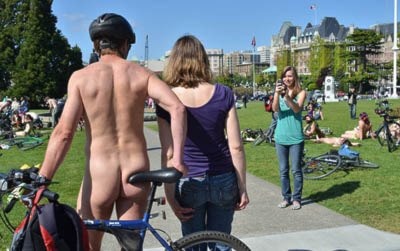The wind beneath your seat
Bare as you dare is the theme of this year’s World Naked Bike Ride in Victoria and there’s still time to join those daring bare bums as they cycle around the city this weekend.
“Everyone has different reasons for riding and getting naked; for some, it’s to expose the vulnerability of the human body, for others it’s the vulnerability of the planet,” says Michael Ward, this year’s event organizer. “It really can be a funny thing to see — about 100 people whipping past, naked, on a bike — but there are also real valid statements around this event: we want people to ask questions and say ‘What is going on?’”
This Saturday, June 9, marks the ninth-annual event in Victoria with riders gathering at 3 p.m. at the legislature grounds. It’s also the 20th event worldwide. Snow, rain or blistering heat, over 70 countries join in the free-wheeling affair, all riding their own routes the same day in the northern hemisphere, and in March in the southern hemisphere.
Ward, who is a fourth-generation naturalist, has ridden completely naked in the Victoria ride for the last seven years, and in Vancouver before that. In fact, his two sons join him in the ride and, this year, even their girlfriends will be joining in as well. Tasha Diamant, creator of the Human Body Project, will also be staging her June demonstration at 2 p.m. the same day.
For those interested in coming out for their first time, Ward clarifies that riding naked is really no less comfortable than riding clothed — as long as you have a comfy seat, you even avoid chafing against inseams and tearing your pant legs. However, he says, you have to be on your bike and with the group or the police will have reason to ticket you for indecent exposure. “It’s quite an addictive experience,” says Ward. “Often we’ll see people or bikers driving by peel off their clothes and join in the fun.”
Who turned the lights off?
No, your internet didn’t stop working, but those who noticed the thousands of websites blacked out this week may get the drift that something is off.
A nationwide day of protest took place Monday, June 4, both in the virtual world and the real one, as the “Black Out Speak Out/Silence, On Parle” campaign asked Canadians in every province to take a stance against the controversial federal Bill C-38 — a bill that would replace the Canadian Environmental Assessment Act and enable the federal government to limit the actions of charities and loosen the restrictions on environmental review processes.
“What’s emerging in Canada — with the dismantling of scientific institutions, widespread muzzling of federal scientists, persistent attacks on environmental charities — is a government eager to silence the voices of Canadians it finds inconvenient,” says Dr. Andrew Weaver, Canada Research chair in Climate Modeling and Analysis at UVic. “It’s evident that the Harper government is willing to mortgage our future in order to maximize short-term profits from the tar sands. What we’re seeing today is that Canadians are not willing to stand for that.”
In Victoria, a total of over 250 people rallied at NDP MP Denise Savoie’s office downtown, and Green MP Elizabeth May’s office in Sidney to voice concerns about the bill, which also includes a controversial $8-million fund for Canada Revenue Agency to specifically audit charities.
Tom Siddon, former Conservative fisheries minister called the action “worthy” and says that the argument surpasses party politics. “This is about political leadership; it’s about distinguishing between a government approach, which is only concerned about the pocketbook issues, and the more serious and profound value we place on Canada.”
Nobody likes a bully
Those who were picked on in school might be thrilled to learn that the province announced its plan for the 10-step ERASE program this week, which aims to eradicate bullying in schools. But while the program is welcomed by teachers around the province, some are saying it won’t do enough.
“We’ve been concerned that the existing standards have been too weak and the government has not enforced them consistently around the province,” says B.C. Teachers’ Federation first vice-president Jim Iker. “Now, we expect that the legal framework should be tightened and enforced province-wide.”
ERASE stands for “Expect Respect And a Safe Education,” and includes a five-year education strategy for educators and community partners to identify and deal with different kinds of bullying. There’s also a smart phone app for students to anonymously report bullying, safety coordinators assigned for each school district, enhanced codes of conduct and a provincial advisory board composed of educators, police and social agencies to counsel government on bullying issues. The program does not, however, specifically deal with LGBTQ issues and, currently, less than one-third of B.C.’s 60 school districts have passed sexual orientation policies protecting LBGTQ youth.
Beginning September, the $2-million strategy will enhance the 2006 Safe Schools Act, which made codes of conduct mandatory to prevent bullying. M
